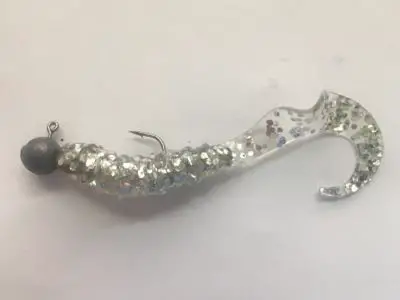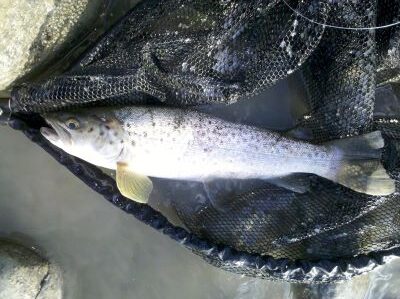I was recently asked if it is possible to catch trout on a Ned Rig. Well, I must admit I do not keep up with bass fishing terminology, so I had to google to familiarize myself with the name. Turns out, I did know the technique just not the name.
Trout can be caught on a Ned Rig and works particularly well over shallow flats. I typically start with a 1/16oz jighead and a 2” length of floating worm. Consider cutting a 4” worm in half if it is too long.
What is the ned rig?
If you are like me, and not familiar with the term. Ned rigging is a technique that involves ‘hopping’ a soft plastic worm or crawfish-style lure across the bottom. The technique was named after outdoor writer Ned Kehde.
The rig is simple, which involves using a jighead with a floating style bait. When fishing for trout I typically use a 1/16 or 1/32oz jighead. Just enough weight to cast out and allow the rig to sink to the bottom.

Thread the jighead through the end of the bait and cast it out. Then allow the rig to gently float to the bottom. Then using a slow retrieve ‘hop’ the bait along the bottom.
The technique requires gently jerking the rod with a tight line, this lifts the bait off the bottom causing it to hop alone. Pause briefly before continuing. You want the lure to hop or jump along the bottom. When targeting trout a slow presentation works best.
Where to fish a ned rig for trout?
I find the ned rig works best in Stillwater where the trout patrol in search of food. It is less effective in moving water where the trout are stationary.
This is a technique I use when fishing clean, relatively flat bottoms. Because the lure bounces along the bottom it will certainly find any weed or debris on the bottom and will likely snag.
It is possible to fish it from the shore, but I feel it is best from a boat. I position my boat to slowly drift over the bottom I wish to visit and cast in front or to the side. If the wind is causing the boat to drift too quickly it is a good idea to use a drogue to control the speed.
How about in rivers and moving water?
I know one angler who has quite a bit of luck fishing half of a plastic tube bait in deeper floating rivers. In moving water, a slightly heavier jighead is often required to reach the bottom.
If you suspect the trout are holding close to the bottom, then it is certainly worth a try. Fish the Ned Rig like a spoon and swing it across the pool, slowly bouncing and hopping it across the bottom.
When the trout are feeding higher in the water column it will be better to fish an inline spinner or jerkbait.
Which lure or bait patterns worth best for trout?
I try to “match the hatch”, which means I fish patterns and colors which resemble the natural food in the pond or lake.
When selecting the bait, it is important to remember that the technique requires a bait that floats. The jighead provides the weight, and the tail needs to float up off the bottom to better represent a living creature.
If the lake is full of tiny baitfish, I will fish a small shad. If it contains a large population of crayfish I will use a crawdads pattern. I do not use crawdad patterns often enough to give a firm recommendation.
If neither are present in significant numbers it is hard to go past the time-tested worm imitation. The Berkley PowerBait Power Floating Trout Worm is a great option. Sometimes I cut them in half to reduce missed strikes.
What is the best jig head?
Most styles of jig heads seem to work, but the technique traditionally uses a mushroom-shaped head. I also do not like any lead inside the body of the bait because that weighs it down. I have great success with tungsten jigheads, they are a bit smaller and more streamlined than the lead alternatives.
The round head does allow the bait to rotate and stand up more freely during the pause phase of the retrieve.
I do not believe the jig head color matters too much, half the time it will be buried in the sediment anyway. I mostly just use the natural metallic color.
When targeting trout, I typically use a 1/16oz jig head. This allows the lure to sink nice and slow giving the trout plenty of time to inspect and strike on the drop. Trout fishing is all about a slow presentation. Sometimes, when fishing tiny worms, in very shallow conditions I will use a 1/32oz.
If targeting trout in very deep water, or if you can not cast far enough with a 1/16oz head then a heavier jig head might be required, but keep in mind it will sink fast and might even increase the risk of snagging.
Does it work on stock or wild trout?
A Ned Rig is an effective technique for catching both stock and wild trout.
But, I predominantly use it when targeting wild trout when they are getting a bit reluctant to go after more traditional presentations.
Stock trout, at least at times will eat anything even slightly resembling food. It is a fun technique and a good one to have in your arsenal no matter the type of trout you are targeting.
How does it compare against other techniques?
To be honest, it is not my main trout fishing style but it is a useful technique to have in your arsenal. Even when fishing still water, I usually prefer to use my fly rod and use a nymph below a dropper.
It is really only a technique I use once the wind picks up and I struggle to sight fish. Even then, I personally prefer to use floating jerkbaits and fish them close to the bottom and round structures such as weedbeds.
Do I need special gear or tackle?
I find a standard ultralight trout combo works just fine and is light enough to casts the lightweight jigheads. A slightly longer rod, greater than 7ft can come in handy to impart more action especially when the lure is far from the shore.
Follow the links for trout rod and reel recommendations.

